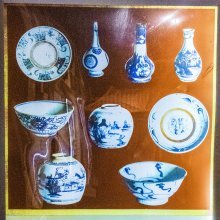Mekala, Mekalā, Mēkala: 15 definitions
Introduction:
Mekala means something in Buddhism, Pali, Hinduism, Sanskrit, the history of ancient India. If you want to know the exact meaning, history, etymology or English translation of this term then check out the descriptions on this page. Add your comment or reference to a book if you want to contribute to this summary article.
Images (photo gallery)
In Hinduism
Purana and Itihasa (epic history)
Source: Cologne Digital Sanskrit Dictionaries: The Purana Index1) Mekalā (मेकला).—The capital of the Puṣpamitras;1 rule of seven kings from.2
2) Mekala (मेकल).—A Vindhyan tribe.*
- * Brahmāṇḍa-purāṇa II. 16. 63; Matsya-purāṇa 114. 52.
Mekala (मेकल) is a name mentioned in the Mahābhārata (cf. VI.10.39, VI.47.13, VI.83.9, VIII.17.3, VIII.17.20) and represents one of the many proper names used for people and places. Note: The Mahābhārata (mentioning Mekala) is a Sanskrit epic poem consisting of 100,000 ślokas (metrical verses) and is over 2000 years old.

The Purana (पुराण, purāṇas) refers to Sanskrit literature preserving ancient India’s vast cultural history, including historical legends, religious ceremonies, various arts and sciences. The eighteen mahapuranas total over 400,000 shlokas (metrical couplets) and date to at least several centuries BCE.
Natyashastra (theatrics and dramaturgy)
Source: Wisdom Library: Nāṭya-śāstraMekala (मेकल) is the name of a mountain said to be located within the Dākṣiṇāpatha (Deccan) region. Countries within this region pertain to the Dākṣinātyā local usage (pravṛtti) according to the Nāṭyaśāstra chapter 14. These pravṛttis provide information regarding costumes, languages, and manners in different countries of the world.

Natyashastra (नाट्यशास्त्र, nāṭyaśāstra) refers to both the ancient Indian tradition (shastra) of performing arts, (natya—theatrics, drama, dance, music), as well as the name of a Sanskrit work dealing with these subjects. It also teaches the rules for composing Dramatic plays (nataka), construction and performance of Theater, and Poetic works (kavya).
Shaktism (Shakta philosophy)
Source: Wisdom Library: ŚāktismMekala (मेकल) is the name of a Śāktapīṭha mentioned in the Kulārṇavatantra. The Kulārṇava-tantra is an important 11th century work for the Kaula school of Śāktism. It refers to eighteen such Śākta-pīṭhas (e.g. Mekala) which is defined as a sacred sanctuary of Devī located here on earth. According to legend, there are in total fifty-one such sanctuaries (pīṭha) on earth, created from the corresponding parts of Devī’s body,

Shakta (शाक्त, śākta) or Shaktism (śāktism) represents a tradition of Hinduism where the Goddess (Devi) is revered and worshipped. Shakta literature includes a range of scriptures, including various Agamas and Tantras, although its roots may be traced back to the Vedas.
Kavya (poetry)
Source: Shodhganga: The Kavyamimamsa of RajasekharaMekala (मेकल) is the name a locality mentioned in Rājaśekhara’s 10th-century Kāvyamīmāṃsā.—It is the part of Vidhya range called Amarakantaka. From where the river Narmadā rises.

Kavya (काव्य, kavya) refers to Sanskrit poetry, a popular ancient Indian tradition of literature. There have been many Sanskrit poets over the ages, hailing from ancient India and beyond. This topic includes mahakavya, or ‘epic poetry’ and natya, or ‘dramatic poetry’.
Jyotisha (astronomy and astrology)
Source: Wisdom Library: Brihat Samhita by VarahamihiraMekalā (मेकला) refers to a country belonging to “Pūrvā or Pūrvadeśa (eastern division)” classified under the constellations of Ārdrā, Punarvasu and Puṣya, according to the system of Kūrmavibhāga, according to the Bṛhatsaṃhitā (chapter 14), an encyclopedic Sanskrit work written by Varāhamihira mainly focusing on the science of ancient Indian astronomy astronomy (Jyotiṣa).—Accordingly, “The countries of the Earth beginning from the centre of Bhāratavarṣa and going round the east, south-east, south, etc., are divided into 9 divisions corresponding to the 27 lunar asterisms at the rate of 3 for each division and beginning from Kṛttikā. The constellations of Ārdrā, Punarvasu and Puṣya represent the eastern division consisting of [i.e., Mekalā] [...]”.

Jyotisha (ज्योतिष, jyotiṣa or jyotish) refers to ‘astronomy’ or “Vedic astrology” and represents the fifth of the six Vedangas (additional sciences to be studied along with the Vedas). Jyotisha concerns itself with the study and prediction of the movements of celestial bodies, in order to calculate the auspicious time for rituals and ceremonies.
In Buddhism
Theravada (major branch of Buddhism)
Source: Pali Kanon: Pali Proper NamesName of a tribe, occurring in a nominal list. Ap.ii.359; the reading is, however, very uncertain.
Theravāda is a major branch of Buddhism having the the Pali canon (tipitaka) as their canonical literature, which includes the vinaya-pitaka (monastic rules), the sutta-pitaka (Buddhist sermons) and the abhidhamma-pitaka (philosophy and psychology).
India history and geography
Source: Project Gutenberg: Castes and Tribes of Southern India, Volume 11) Mekala (“goat”) is one of the many exogamous septs (division) among the Boyas (an old fighting caste of Southern India). The Boyas were much prized as fighting men in the stirring times of the eighteenth century .
2) Mekala (“goats”) is one of the exogamous septs (divisions) among the Kapus (the largest caste in the Madras Presidency). The Kapus or Reddis (Ratti) appear to have been a powerful Dravidian tribe in the early centuries of the Christian era. The term Kapu means a watchman, and Reddi means a king.

The history of India traces the identification of countries, villages, towns and other regions of India, as well as mythology, zoology, royal dynasties, rulers, tribes, local festivities and traditions and regional languages. Ancient India enjoyed religious freedom and encourages the path of Dharma, a concept common to Buddhism, Hinduism, and Jainism.
Languages of India and abroad
Sanskrit dictionary
Source: DDSA: The practical Sanskrit-English dictionaryMekala (मेकल).—
1) Name of a mountain; (also mekhala).
2) A goat.
Derivable forms: mekalaḥ (मेकलः).
Source: Cologne Digital Sanskrit Dictionaries: Shabda-Sagara Sanskrit-English DictionaryMekala (मेकल).—mf.
(-laḥ-lā) 1. Name of a certain part of Vind'hya mountain. 2. A goat.
Source: Cologne Digital Sanskrit Dictionaries: Cappeller Sanskrit-English DictionaryMekala (मेकल).—[masculine] [plural] [Name] of a people.
Source: Cologne Digital Sanskrit Dictionaries: Monier-Williams Sanskrit-English Dictionary1) Mekala (मेकल):—m. Name of a mountain in the Vindhya, [Viṣṇu-purāṇa; Haravijaya]
2) (?) of a Ṛṣi (father of the river Narma-dā), [ib.]
3) [plural] of a people, [Mahābhārata]
4) of a dynasty, [Viṣṇu-purāṇa]
5) Mekalā (मेकला):—[from mekala] f. Name of the river Narma-dā (Nerbudda), [ib.]
6) [v.s. ...] of a town, [ib.],
Source: DDSA: Paia-sadda-mahannavo; a comprehensive Prakrit Hindi dictionary (S)Mekala (मेकल) in the Sanskrit language is related to the Prakrit word: Meala.
[Sanskrit to German]
Sanskrit, also spelled संस्कृतम् (saṃskṛtam), is an ancient language of India commonly seen as the grandmother of the Indo-European language family (even English!). Closely allied with Prakrit and Pali, Sanskrit is more exhaustive in both grammar and terms and has the most extensive collection of literature in the world, greatly surpassing its sister-languages Greek and Latin.
See also (Relevant definitions)
Starts with: Mekaladri, Mekaladrija, Mekalai, Mekalaka, Mekalakanya, Mekalakanyaka, Mekalakanyakatata, Mekalaparam, Mekalapatam, Mekalaprabhava, Mekalarekai, Mekalashaila, Mekalashailakanya.
Query error!
Full-text (+8): Mekalakanyaka, Mekaladrija, Mekalashaila, Mekalakanya, Mekaladri, Mekhala, Melaka, Mekalashailakanya, Mekalaprabhava, Mekalakanyakatata, Mekalaka, Meala, Ekala, Mani-mekalateyvam, Mekalarekai, Mekhalakanyaka, Narmada, Nritta, Nritya, Tapasvin.
Relevant text
Search found 38 books and stories containing Mekala, Mekalā, Mēkala; (plurals include: Mekalas, Mekalās, Mēkalas). You can also click to the full overview containing English textual excerpts. Below are direct links for the most relevant articles:
List of Mahabharata tribes (by Laxman Burdak)
World Journal of Pharmaceutical Research
Kinetics of enrofloxacin with sodium calcium aluminosilicate. < [2015: Volume 4, May issue 5]
Anti-diabetic activity of reported medical and aromatic plants < [2018: Volume 7, April issue 7]
Evaluation of phytochemicals and properties of Salicornia brachiata. < [2017: Volume 6, August issue 8]
Padma Purana (by N.A. Deshpande)
Chapter 105 - Nahuṣa is Born < [Section 2 - Bhūmi-khaṇḍa (section on the earth)]
Chapter 6 - Bhāratavarṣa: Its Rivers and Regions < [Section 3 - Svarga-khaṇḍa (section on the heavens)]
Brahma Purana (critical study) (by Surabhi H. Trivedi)
Appendix 9 - Chart of Ethnic Data provided by Various Puranas
15. List of Weapons < [Chapter 11 - Political Structure]
Mahabharata (English) (by Kisari Mohan Ganguli)
The Matsya Purana and the Ramayana < [Purana, Volume 8, Part 1 (1966)]
Some Geographical and Ethnic Data of Matsya Purana < [Purana, Volume 6, Part 2 (1964)]
Literary and Archaeological Evidence on the Aryan Expansion in India < [Purana, Volume 6, Part 2 (1964)]

